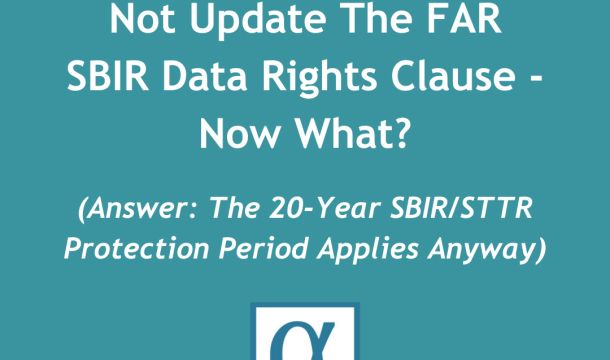The GovCon Bulletin™
A Closer Look At DoD's Guidance on Inflation and EPA Clauses
Against the backdrop of an economy grappling with runaway inflation, in late May, the U.S. Department of Defense (DoD), issued a memorandum titled Guidance on Inflation and Economic Price Adjustments (Guidance). Unfortunately, the Guidance offers little relief to federal government contractors trying to manage today’s inflationary pressures in their existing contracts. Indeed, the Guidance focuses mostly on how contracting officers (CO's) can use economic price adjustment (EPA) clauses in new contracts to mitigate future cost risks to the government and to contractors.
But first, the Guidance briefly lays out the current state of play for companies under contract now. Specifically, the Guidance acknowledges that for purposes of existing DoD contracts, the treatment of cost increases that are caused by economic conditions such as inflation depends on the type of contract that government contractors are working under. The federal government bears the greatest risk of increased costs, including those caused by inflation, under cost reimbursement contracts. Once a contractor under a cost reimbursement contract provides the required notice that costs are approaching contract limitations, a contractor is not required to continue performing beyond funding limitations and the federal government can increase funding for continued performance.
The Guidance acknowledges that fixed-price contracts can accommodate increased costs resulting from inflation only in two circumstances. First, if the contract is a fixed-price incentive firm target contract (FPIF contract), then the contractor’s target profit can be adjusted when actual costs exceed target costs. Second, if a fixed-price contract includes an economic price adjustment (EPA) clause (FPEPA contract) under which the contract price can be adjusted when certain contingencies arise such as changes in the cost of labor or materials or changes in cost indices for labor or material, then the government will bear the cost risk up to any limits specified in the EPA clause. The Guidance reiterates that contractors under fixed-price contracts that are not FPIF or FPEPA contracts bear the risk of cost increases, including those due to inflation.
In short, for contractors currently performing under contract, the Guidance starts out painting the unfortunate reality that contracting rules currently provide limited avenues for government contractors to recover escalating costs caused by inflation.
The remainder of the Guidance, then, largely serves to assist contracting officers as they consider whether to insert EPA clauses in new contracts. Indeed, DoD's note of encouragement comes in the form of a suggestion that EPA clauses may lead to more grounded pricing proposals. Specifically, the Guidance anticipates that the use of EPA clauses will encourage government contractors to work under fixed price contracts that are not priced based on worst-case projections, since FPEPA contracts provide a mechanism for mitigating cost-risks attributable to unstable market conditions.
Instructing CO's further, and citing FAR clause 16.203-4 and DFARS clause 216.203-4, which both anticipate the use of EPA clauses when contract performance will occur over extended periods, the Guidance advises that contract length should be “one of the primary considerations when deciding whether to use an EPA clause.”
The Guidance also counsels contracting officers to use an index that is closely related to costs that are judged to be most unstable when selecting an index to measure inflation under EPA clauses. At the same time, the index should be broad enough that it will not be significantly affected by a single company.
Similarly, contracting officers are encouraged to limit the EPA clause to costs most likely susceptible to economic fluctuations while excluding other costs not so susceptible, such as labor costs that are locked in by definitive union agreements.
The Guidance also cautions CO’s to craft EPA clauses that are fair to both parties. For example, under the Guidance, a fair EPA clause (1) allows for both upward adjustment and downward adjustments of the stated contract price; (2) uses the same index to establish the negotiated price and to adjust the negotiated price; and (3) incorporates ceilings and floors on adjustments that are of equal magnitude.
The Guidance sets out additional principles CO’s should adhere to:
- EPA clauses should adjust contract prices based on pre-established formulas so that CO's avoid simply reopening price negotiations.
- Any contingency allowances covered by EPA clauses should be excluded from the base contract price.
- Each EPA clause should clearly explain price adjustment mechanics, as well as triggers for those adjustments.
The Guidance warns CO’s that any clause that addresses potential contract costs or price changes due to economic conditions (like inflation) is effectively an EPA clause even if the term is not used in the contract. Thus, the Guidance applies to those clauses as well.
The Guidance also identifies additional resources CO’s should look to when using EPA clauses:
- Local pricing and policy offices
- The Defense Contract Management Agency or Defense Contract Audit Agency
- Guidance set forth in DFARS PGI 216.203-4
- Agency legal counsel
It seems reasonable to assume that DoD’s Guidance will spur an uptick in the use of EPA clauses in DoD fixed-price contracts. DoD government contractors that anticipate performing under new fixed-price contracts, particularly contracts that will span multiple years, should therefore examine the Guidance to better prepare themselves for contract negotiations over significant EPA clause provisions, including those that identify a cost or inflation index. Although the use of EPA clauses seems to favor DoD contractors in the current economic climate, contractors should never lose sight of the fact that EPA clauses can work both ways and result in downward pricing adjustments.



